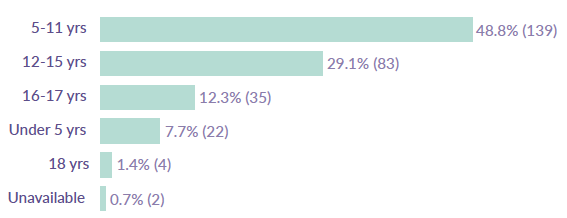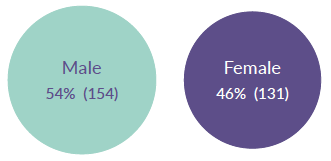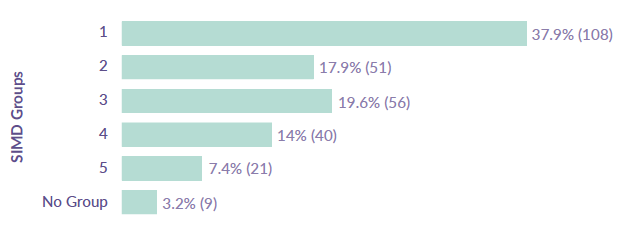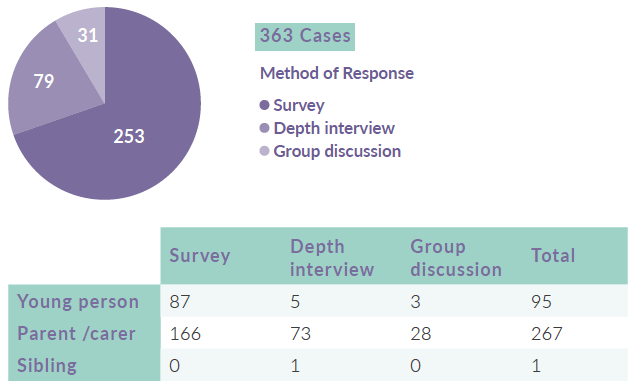Rejected referrals to child and adolescent mental health services: audit
A qualitative and quantitative audit of rejected referrals to Child and Adolescent Mental Health Services (CAMHS).
Aims And Objectives
To explore the experiences of children, young people and their families referred to CAMHS but who did not subsequently receive them.
Objectives
1. To understand the causes and reasons for rejected referrals across Scotland and the impact this has on children, young people and their families
2. To establish whether particular groups are disproportionately affected and, if so, to consider solutions
3 .To understand what happens to a young person who receives a rejected CAMHS referral in terms of signposting to other services or further support
4. To understand outcomes for those whose referral was rejected, but who subsequently received support from other services
5. To understand referrals to CAMH specialist services in terms of their volume, purpose, source, and nature
6. To provide recommendations which will improve the experience of children, young people and their families referred to CAMHS Tier 2, 3 and 4 services, but who may not subsequently receive them ( rejected) and understand outcomes for children and young people whose referrals are rejected
7. To provide recommendations around improvements and any ongoing data requirements
Methodology introduction
The research was divided into two elements: qualitative and quantitative. The quantitative element examined data supplied by seven Audit Boards relating to 285 children and young people whose referrals to CAMHS were rejected during February 2018. The qualitative element used interviews, focus groups and an online survey, involving 363 people over the period December 2017 to April 2018.
Methodology: quantitative
The quantitative element of this research was conducted by ISD Scotland and supported by staff in the participatory NHS Boards in Scotland.
All 14 NHS Boards across Scotland were invited to take part in the audit. The following seven NHS Boards participated:
- NHS Ayrshire & Arran
- NHS Borders
- NHS Dumfries & Galloway
- NHS Fife
- NHS Forth Valley
- NHS Greater Glasgow & Clyde
- NHS Highland
Within these seven Audit Boards in 2017, there were:
- 17,373 referrals
- 8,943 children and young people starting treatment
- 3,684 rejected referrals
The seven Audit Boards account for 52% of the referrals, 56% of the patients starting treatment and 51% of the rejected referrals across Scotland during 2017. The seven Audit Boards provide services to urban, remote and rural populations and within these areas there are a mixture of deprived areas and the more affluent. The latest performance figures for children and young people seen within 18 weeks by CAMHS varies across the Audit Boards. They are considered representative of the overall Scotland position – further information can be found here .
The Audit Boards were asked to collect data on any Tier 2, 3 or 4 CAMHS referral for a child or young person under the age of 18 received during 1 to 28 February 2018 (inclusive) where the referral was rejected. The month of February was chosen as there is less seasonal variation compared with other months (see figure 1).
Each Audit Board was provided with a specific list of data items to be collected for the audit and these consisted of data items that NHS Boards routinely collect about each patient. Audit Boards were asked to record the findings based on their current referral protocol and practice to ensure the methodology remained consistent. In addition, each participating Audit Board was asked to provide details of their referral criteria and the process for rejecting a referral.
The Audit Boards then provided this data to ISD, where the referral to CAMHS had been rejected. This data was then analysed.
In order for ISD to carry out this project, approval was sought from the Public Benefit and Privacy Panel as patient identifiable information was being collected. This work was approved by the Panel. ISD adhere to strict confidentiality rules and more information is available at www.isdscotland.org/About-ISD/Confidentiality.
Quantitative sample profile
The total number of referrals received by the seven Audit Boards for the month of February 2018 was 1,528 and of these 285 (19%) were reported as rejected.
Data relating to these 285 cases was examined.
The Community Health Index ( CHI) number was used to identify the age groups and gender of children and young people who had their referral to CAMHS rejected during February 2018. It is acknowledged that the gender represented by CHI may differ from the child or young person’s gender identity or expression. As shown in Figure 4 almost half of the children and young people (49%) who had their referrals to CAMHS rejected were between 5-11 years of age and another 29% of the children and young people were between 12-15 years of age.
Figure 4: Age of the children and young people on referral in seven participating audit boards

Source: ISD CAMHS Rejected Referrals Audit
Figure 5 provides the percentage distribution by gender of those included in the quantitative study, it shows that more males than females had their referral rejected by CAMHS and that there was a slightly different split compared with the qualitative study.
Figure 5: Gender distribution of rejected referrals in seven participating audit boards

Source: ISD CAMHS Rejected Referrals Audit
Location
During the audit the postcode of the children and young people was collected which was then matched to the publication of Scottish Index of Multiple Deprivation ( SIMD) and used to identify the spread between the deprivation groups of the referred children and young people.
SIMD ranges from Group 1 ‘most deprived’ to Group 5 ‘least deprived’. The results in Figure 6 shows that over half (56% - 159) of children and young people referrals that were rejected came from the most deprived areas (Group 1 and 2). This observation is likely to be linked to the rate of referral from these communities to CAMHS rather than disproportionate rejection of those referrals. However, no data is available nationally for identifying deprivation for all children and young people referred to and seen by CAMHS, but this pattern is reflected in other mental health information. [8]
Latest National Records Scotland published population figures show that there are 1,031,761 individuals under the age of 18 in 2016. For the Audit Boards, their population of under 18’s in 2016 was 530,046 (52% of the total under 18 population). This is reflective of the sample of referrals and rejected referrals to CAMHS. [9]
Figure 6: Distribution of rejected referrals by SIMD

Source: ISD CAMHS Rejected Referrals Audit
Methodology - qualitative
The purpose of the qualitative research was to gather detail and depth of views from children, young people and their families who had experienced a rejected referral from CAMHS.
A flexible methodology was adopted which allowed adaptation as the project progressed. The eligibility criteria were that people had to have themselves been referred to CAMHS and had the referral rejected within the last two years, or have a child or sibling with this experience. This research also sought the view of GPs and teachers who have referred into the CAMHS system.
A screening survey was used, asking people to register their interest in taking part and provide some basic details to check their eligibility and gather data on gender and age of the young person who was rejected. The survey questions can be found at Appendix One.
A total of 540 young people and their families registered their interest, 304 of whom were eligible to participate. Those who met the criteria were then invited either to a focus group in their local area or to take part in a telephone interview. Initially, we expected that the majority of people would take part in focus groups. However, it became clear that these were difficult for many people to attend, primarily because of employment, caring commitments or the personal nature of their experience. The focus was therefore switched to conducting telephone interviews. Focus groups and telephone interviews used a topic guide to provide structure and to ensure all facilitators asked consistent questions of participants. The topic guide can be found at Appendix Two.
Focus groups and interviews were of most interest to parents and carers, rather than young people themselves. It was important to hear the voices of young people directly, so towards the end of the project, a semi-structured online survey was used. The questions for this survey can be found at Appendix Three.
Figure 7: Qualitative methodology process
| Screening survey | Contact made with all eligible participants | Group sessions | Telephone depth interviews | Semi-structured online survey |
|---|---|---|---|---|
|
|
|
|
|
Source: SAMH
Trained facilitators ran all groups and depth interviews, which were all recorded and transcribed. Analysis of qualitative data was undertaken using NVivo software and online surveys were created and administered using Snap Survey software. All research was undertaken in strict accordance with the Market Research Society code of conduct and with child protection legislation.
We use quotations to illustrate findings from the focus groups and interviews. Quotes used are verbatim and have been anonymised. References to geographic locations have been removed, to avoid identifying individuals. We have presented some statistics from the online survey. We have also given the numbers involved in the different components of the qualitative research (e.g. interviews, focus groups and surveys).
Qualitative sample profile
In total the qualitative research heard from 363 people, of whom 267 (74%) were parents and carers, 95 (26%) were young people and 1 was the sibling of a young person who had been referred to CAMHS.
Four group sessions were held in Edinburgh, Glasgow and Stirling with 31 people participating. 79 people participated in a telephone depth interview. 253 people took part via an online survey.
Young people were more likely to respond via the survey, while parents and carers were happy to take part in face to face or telephone interviews. Figure 8 illustrates the profile of respondents by method used.
Depth interviews were conducted with nine GPs from several different NHS Board areas. Almost all had over 10 years’ of experience as a GP and all had experience of referring to CAMHS.
Twenty-four teachers with experience of referring to CAMHS participated in an online survey. Of those teachers 14 were from a primary school, 9 from a secondary school and one from an additional supports needs school. A survey was adopted for this group as we had initial interest from 106 teachers and did not want to exclude anyone from participating.
Figure 8: Profile of responses to qualitative research by method used

Source: ISD CAMHS Rejected Referrals Audit
Figure 9 shows the age and gender breakdown of the children and young people whose referrals to CAMHS were discussed across all methods of the qualitative research, these figures were taken from the screening survey. The largest group was aged 5-11 years (39%) followed by 16-18 years (29%) and 12-15 years (25%).
Figure 9: Age and gender of the child or young person whose referral was rejected
| Gender of child or young person referred | |
|---|---|
| Male | 160 |
| Female | 195 |
| Self described | 6 |
| Not stated | 2 |
| Age of child or young person referred | |
|---|---|
| 0-4 yrs | 7 |
| 5-11 yrs | 142 |
| 12-15 yrs | 92 |
| 16-18 yrs | 107 |
| 19-25 yrs | 8 |
| 26+ yrs | 1 |
| Not stated | 6 |
Source: ISD CAMHS Rejected Referrals Audit
Limitations
As with any research project, there are some limitations that should be borne in mind. Generally the data provided to ISD from the Audit Boards was of good quality. Some manual manipulation was required to get it to a consistent format. This is as a result of different IT systems used by NHS Boards to record CAMHS data. ISD shared the analysis and asked each Audit Board to confirm that that their data was accurate. It should also be noted that this project relates to only one month of data from seven Audit Boards.
The qualitative research was conducted with a self-selecting sample, meaning that only those willing to speak out about their experiences (referrers, children, young people and their families) participated, these were largely negative experiences.
Due to self-selecting sample and timeframes the research is also limited in terms of establishing if particular groups were disproportionately affected as was set out in the objectives. It would require a different approach to examine this but would be a worthwhile undertaking.
Due to the multiple channels used to recruit participants, it is not possible to identify whether there are any instances of someone participating in both a group or telephone interview and the online survey. It is anticipated that it is highly unlikely this has happened, simply due to the time and effort required by the participant, however it cannot be categorically stated that there are no duplicates. Due to the need for confidentiality and data protection, there is also the potential for a parent and young person to both participate without researchers being able to identify this. Again, it is reasonable to assume this is not a widespread issue as young people aged less than 16 years were required to gain parental consent to participate across all qualitative methods. In any case, the viewpoint of both parents and young people is valid and useful.
Although there is representation in the qualitative sample from almost all health boards, due to small numbers in each area, it is not possible to draw any conclusions about how CAMHS operates in an individual area.
“You start thinking, this is me getting help, I’m actually going to better myself, things are going to go right from now on, and then it’s like constantly downhill from there. Every time you need to interact with CAMHS it’s a nightmare.”
(young person, group)
Contact
An easy-read version is available on request from MentalHealthStrategyandCoordinationUnit@gov.scot.
There is a problem
Thanks for your feedback